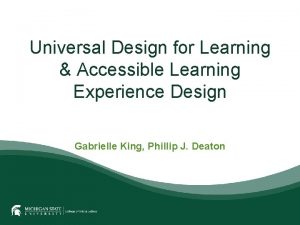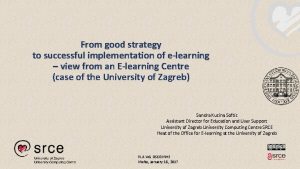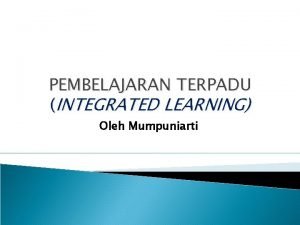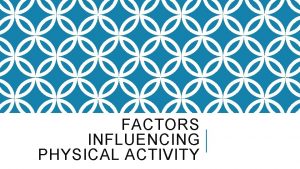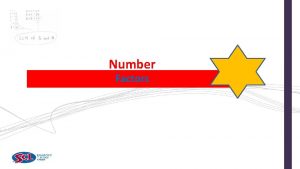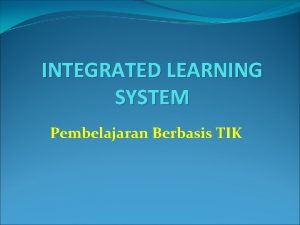Factors Constraining the Implementation of Work Integrated Learning















- Slides: 15

Factors Constraining the Implementation of Work Integrated Learning in Namibia’s Higher learning institutions. By: Silohenda H. Amuthenu

TABLE OF CONTENTS OVERVIEW ü STATEMENT OF THE PROBLEM ü METHODOOGY ü KEY FINDINGS ü SUGGESTIONS ü CONCLUSSIONS ü 2

Context q Namibia higher education is distiquished from its tertiary and other q q q education, it excludes vocational education universities that offers lower level qualifications. The scope is small with 3 higher education institutions Very young , developed in the late 1980 s/1990 s after independence, WIL is not new it has been practiced in vocational oriented programs and in HEIs it has been practiced on traditional disciplines such as in education, engineering and medical disciplines 3

Background of the study q WIL is internationally recognized and as the new powerful form of q q q engaged pedagogy which combines theoretical knowledge with practical work experience. Globally, the level of development of cooperative education and work-integrated learning varies from country to country. Namibian institutions have acknowledged WIL and this is evidently from the inclusion of WIL in strategic objectives and the establishment of cooperative units. The government started facilitating discussions with regards to WIL by establishing a “working committee”. 4

Problem statement q Despite the Namibian government conducting awareness campaigns to encourage local Higher Learning Institutions (HLIs) to implement WIL across all courses, there is anecdotal evidence that shows that there are still some undergraduate courses that do not engage in such pedagogy, hence questioning the competency of these students. q There is lack of evidence that justifies why higher institutions have not integrated WIL , however literature suggests “There a number of challenges relating to the offering of WIL” as Samadi (2014, p 7). 5

Significance of the study q Hence the study aimed to find out what are the factors constraining the implementation of WIL in higher education institutions in Namibia and suggest possible suggestions for a change. 6

Methodology q A qualitative methodology was employed which looked at the cases of recognized higher education institutions in Namibia (UNAM, NUST, and IUM). q A summative content analysis was used and the source of data was: • Three universities websites and • Peer-reviewed journals of cooperative journals such as the African Journal for Work Based Learning (SASCE) and Asia-Pacific Journal of Cooperative Education, • Different studies were selected from Emerald Publishers, SAGE Journals, Taylor and Francis, Springer and Google Scholar databases. • Other additional genuine materials such as the UNESCO, government reports, strategic plan, and Higher education policies were added to provide the background to the study

q. The articles were collected and checked against descriptors to select the 20 articles that were reviewed. q. The researcher also drew on her personal experiences as a Quality Assurance Officer at one of the higher education institutions in Namibia.

Outside university autonomy Within the university autonomy Poor relationship between institutions/indust ries WIL lessor officers Lack of budgets Finance Lack of national WIL policy Conceptualization of WIL Ensuring of Quality Placements Time tabling / slot allocation

Conclusions drawn from findings : • There is a lot that higher education can improve on for the effective implementation of WIL • Similar challenges are still experienced from the previous century up to now • It shows the level of WIL in a particular system in practice and in research a) improving transformative learning in WIL , b) mentorships as opposed to supervisions and provision of accommodation to students. c) Internalization of WIL • The factors are interlinked to some extend there is a causal relationship effects

Suggestions for Higher Learning Institutions q. Allocate funds for WIL activities in the institutional budgets; q. Create awareness among employees & Acknowledgment (academics and administration staff members) on WIL and offer training workshops on how to successfully integrate Wil in the curriculum; q. Develop working documents on WIL as a reference material for present and future employees; q. Appoint a lessor officers (depending on the number of students) to be the intermediary between students, universities and the industry; q. Engage in critical dialogue to create and maintain create strong sustainable partnerships with industries, other institutions, and the government; q. Provide counseling/orientation to students before placements

Suggestions for the Ministry of Education; q. Launch the national policy on WIL to provide the foundation for WIL activities; q. Provide extra funds for institutions specifically for WIL programmes ; q. Collaborate with the Ministry of Industrialization, Trade and SME Development where all private business is registered to mandate firms to take part in the training of graduates; q. Facilitate the dialogues to promote higher learning institutions collaborations with each other and with the industries.

Suggestions for labor market / Industries q. Take accountability of students learning for the future preparation q. Create and maintain relationships with higher learning institutions q. Supervisors have to take a different role as mentors and facilitators and create safe, interesting and exciting space where students can articulate their thinking freely.

Conclusion q Based on the outcome of an in-depth content analysis, I conclude that higher learning institutions have the ability to implement WIL across all curricula because most factors constraining the implementation are found within their autonomy as opposed to those factors outside their autonomy. q The findings further inform that the success of the implementation of WIL depends heavily on the students as well, hence students should be oriented on how they should manage their own learning outcomes, as the interest in their learning is a moderating variable to the successful implementation of WIL. 14

Guidance on thesis proposal • What are Higher Education Institutions beliefs and understandings of the WIL and why do they have those beliefs and understandings? • How institutions are currently implementing WIL in various programmes across the institutions? • What are the factors that are constraining Higher Education Institutions in implementing Work Integrated Learning in Namibia?
 Love constraining to obedience
Love constraining to obedience Cuadro comparativo de e-learning
Cuadro comparativo de e-learning Ehr implementation work breakdown structure
Ehr implementation work breakdown structure Work implementation plan
Work implementation plan Accessible learning experience design and implementation
Accessible learning experience design and implementation E learning implementation strategy
E learning implementation strategy Integrated learning adalah
Integrated learning adalah Location situation
Location situation Is a flower abiotic or biotic
Is a flower abiotic or biotic Abiotic factors and biotic factors
Abiotic factors and biotic factors Abiotic vs biotic factors
Abiotic vs biotic factors Biotic vs abiotic
Biotic vs abiotic Site and situation factors
Site and situation factors What is the greatest common factor of 16 and 48
What is the greatest common factor of 16 and 48 What are the factors of 7
What are the factors of 7 Fctors of 8
Fctors of 8




